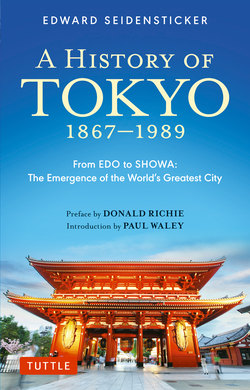Читать книгу History of Tokyo 1867-1989 - Edward Seidensticker - Страница 7
На сайте Литреса книга снята с продажи.
ОглавлениеINTRODUCTION
There can be few cities in the world that live, pulsate, and breathe through their geography as Tokyo does, few cities with a history that shifts through the creases of space as does that of Tokyo. This is particularly ironic in a city whose neighborhoods today hold few distinctive features and whose gentle topography has been all but obscured by batteries of buildings. But it was not always so, and what better way is there of writing Tokyo’s history than by reflecting this shifting geography as neighborhoods prospered and declined while others, more aspirational, climbed up the socio-spatial ladder? This is precisely what Edward Seidensticker does in the pages of these two books, brought here together for the first time under one cover thanks to the efforts of a number of people, including Donald Richie, and the publisher.
Few books in whatever language are so suffused with the spirit of a city as Seidensticker’s classic accounts, suffused with the spirit of the city, but also imbued with the wit of their author. These are not conventional histories. While they are written with a strong sense of history’s ebb and flow, they are held together by their representation of the decline and mar ginalization of a way of life that was at the same time a part of town. Throughout these books, there is a sense of foreboding and of a fatal destiny being played out. But at the same time, there is a lightness of touch and an appropriateness of the chosen detail that provokes a smile, a chuckle, and a raised eyebrow on each reading.
This is definitely not anyone’s Tokyo. It is Seidensticker’s Tokyo. And Seidensticker’s Tokyo starts in the Low City and moves out with it to embrace Asakusa. Much of these two volumes is dominated by the demise of the Low City and all that it stood for, until, that is, more recent years, when the deed is all but done and Asakusa consigned to the role of outpost for tourists. Many of Tokyo’s districts have a part to play in these pages, indeed they are the principal characters, invested with a personality that can change with time but that is rooted in a sense of the almost atavistic attraction of the Low City and the parvenu presumption exhibited by the districts of the High City. So it is that we see the emergence of Ginza from obscurity in the shogun’s city of Edo to shop window for all that was stylish and new. Nihonbashi, the old center of the merchants’ city, was much more sedate, losing out slowly to the nearby district of Marunouchi. Roppongi gets short shrift as an upstart pleasure district that grew up as a result of US military facilities in the post-war period. Shinjuku and Shibuya are the back of beyond, to put it politely.
Alongside the districts, there are a number of buildings whose presence animates these books: the Twelve-Storys tower in Asakusa, destroyed in the great earthquake of 1923; Tokyo Central Station, inconveniently located in the center of the city; Frank Lloyd Wright’s Imperial Hotel, which famously withstood the tremors; the city’s main theatres, prominent among them the Kabukiza and the Shibuya Embujō. And people, too, whose lives have helped to shape the city and define its culture—people like Hattori Kintarō, the founder of Seikō, the watch-making company; or Josiah Conder, the British architect whose influence was seminal in the teaching of architecture in Japan; or Enoken, the most famous and best-loved of Asakusa’s comedians; or the man called Suzuki who built a block in Shinjuku which he optimistically called Kabukichō. But the individuals whose presence most influences the tenor of these books are the many writers who have built at least part of their opus on Tokyo’s ground, not only the likes of Tanizaki Jun’ichirō and Kawabata Yasunari, with whom many of us will already be familiar, but lesser-known authors such as Osanai Kaoru and Takami Jun.
This is a cultural and social history which for all its quirkiness is peppered with enlightening vignettes that create a wider context for Tokyo’s history. It is built around a number of leitmotifs: corruption in high places; new cultures and technologies such as the department store; festivals, performances, theater; the geisha and the licensed quarters. But these two books are far from being orthodox history. They really belong to a genre of their own. It is hard not to reflect on the freedom Seidensticker must have felt writing about Tokyo. On the one hand, he was not translating, with its bondage to the original text. On the other, he was not writing as a historian, and so had no need to adopt the tools of the historian’s trade. Nevertheless, he managed to capture in uncanny ways the telling details of historical change—the transition from feet to wheels in Meiji Tokyo or the change in eating habits after the great earthquake when women started eating out in numbers. This is very much history as it was lived at the time, which is a history reflected in newspaper articles, on stage, in cafés. It is in fact an approach that has more in common with certain traditions of Japanese representations of places and of the past, a cross between topographical writing and satirical social and cultural history. But above all in reading these pages one feels subliminally the presence of Nagai Kafū, the writer whose wistful stories were translated by Seidensticker and whose cultural prejudices are, one senses, shared.
Paul Waley
